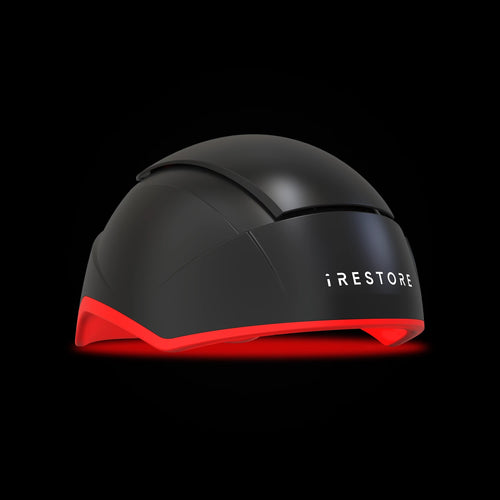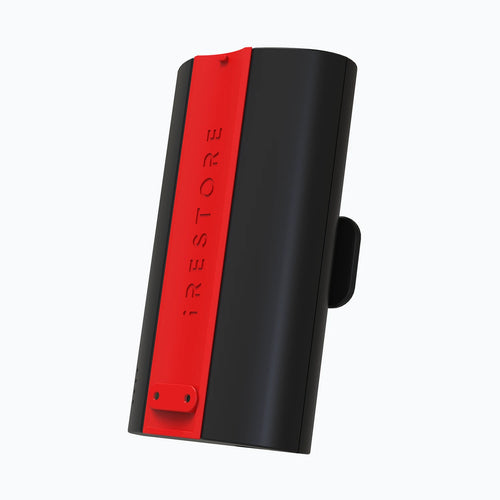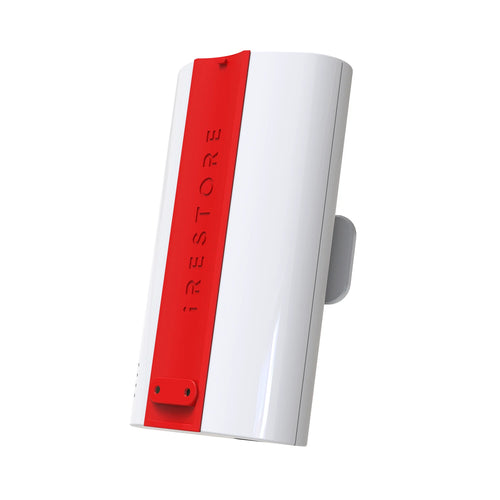If you’ve started noticing a patch of scalp showing through at the top of your head, you’re not alone. Hair thinning at the crown is one of the most common early signs of pattern hair loss. It usually happens when hair follicles in the crown area begin to shrink due to hormonal changes, stress, or poor scalp health, producing finer, weaker strands over time.
In men, it’s often linked to male pattern baldness driven by DHT sensitivity, while in women, it appears as gradual thinning at the crown or part line due to hormonal imbalance, stress, or nutritional deficiencies. Crown hair loss can often be slowed and even reversed if addressed early through consistent scalp care, nutrition, and technologies like red light therapy for hair regrowth that reactivate dormant follicles.
In this guide, we’ll cover how to identify early signs of hair thinning, what’s really causing it, and the most effective ways to regrow hair on the crown naturally including iRESTORE’s clinically proven red light therapy system.
What Does Hair Thinning at the Crown Look Like?
Hair thinning at the crown often starts subtly, a little more scalp showing under bright light, or your hair part appearing wider than usual. For many people, this change happens so gradually that it’s easy to miss until photos or mirrors make it obvious.
In men, it usually shows up as a circular patch of thinning hair on the top of the head, which can slowly expand outward, a pattern linked to male pattern baldness caused by DHT (dihydrotestosterone) sensitivity. In women, it tends to appear as diffuse thinning or a widening part, while the hairline often remains intact.
These early shifts are your follicles signaling distress: either from hormonal changes, stress, or nutrient deficiencies. The sooner you identify them, the more likely it is that the follicles can be reactivated before they shrink permanently.
Early detection and consistent treatment especially with low-level laser therapy (LLLT) can make a major difference in restoring hair density at the crown before the thinning becomes visible from every angle.
Common Causes of Thinning at the Crown
If you’re wondering what common hair loss triggers are, the answer often lies beneath the surface within your hormones, stress levels, and scalp environment. Let’s break down the most common causes that lead to this specific type of crown hair loss and what you can do to prevent further damage.
1. Genetics and Hormones
The most frequent cause of thinning hair on the top of the head is androgenetic alopecia commonly known as pattern baldness. It’s hereditary and driven by sensitivity to dihydrotestosterone (DHT), a hormone that causes follicles at the crown to shrink over time. Early intervention can help prevent these follicles from miniaturizing permanently.
2. Stress and Poor Sleep
Chronic stress and sleep deprivation elevate cortisol levels, which disrupt the hair growth cycle and push follicles prematurely into the telogen (resting) phase, a condition known as telogen effluvium. This leads to shedding concentrated at the crown and temples, where circulation is already weaker.
3. Nutrient Deficiency
Your follicles need consistent nourishment to thrive. Low levels of iron, vitamin D, and biotin can slow down cell renewal and weaken hair roots. A diet lacking in protein or omega-3s can further dull scalp health, especially when combined with stress or hormonal shifts.
4. Scalp Buildup or Hard Water
Exposure to hard water or excess product buildup can block follicles and limit oxygen flow. Over time, this leads to inflammation, reduced nutrient absorption, and a flaky, irritated scalp all of which accelerate crown hair thinning.
No matter the cause, the key is to address it early. Once follicles remain dormant for too long, it becomes harder to restore density but not impossible. Clinical tools like red light therapy for hair regrowth can help reenergize follicles and reverse early thinning when paired with better sleep, nutrition, and scalp hygiene.
Early Signs You Shouldn’t Ignore
Hair thinning at the crown doesn’t happen overnight; it develops gradually, and most people overlook the earliest warning signs until the thinning becomes visible in photos or under harsh light. Recognizing these indicators early gives you the best chance to regrow hair on the crown naturally before follicles shrink permanently.
1. Increased Scalp Visibility
If you’ve noticed the top of your head reflecting more light than usual or your scalp showing through your hair part, it’s one of the first visible symptoms of stunted hair loss. This means your follicles are beginning to miniaturize, producing finer and shorter strands.
2. Widening Hair Part
For many women, female pattern hair loss begins as a widening central part rather than patchy shedding. This gradual change signals a reduction in overall hair density and is best managed with early scalp stimulation and balanced nutrition.
3. Short, Fine “Baby” Hairs Around the Crown
Tiny, uneven hairs near the crown can indicate follicle recovery or, in some cases, breakage due to weak hair shafts. Healthy regrowth usually feels soft and grows steadily over weeks, while breakage stays frizzy or uneven.
4. Excess Shedding During Shower or Brushing
Seeing more strands in your brush or shower drain especially from the top region is often an early stage of telogen effluvium. While daily shedding (50–100 hairs) is normal, consistent excess loss concentrated at the crown signals stress or hormonal disruption.
5. Scalp Sensitivity or Itching
An itchy or tender scalp at the crown can stem from inflammation, buildup, or reduced blood circulation. Left unaddressed, this irritation can slow growth and trigger thinning hair on top of the head.
How to Fix Thinning at the Crown Naturally
If you’ve caught hair thinning at the crown early, you’re already ahead. The goal now is to reactivate dormant follicles, strengthen existing strands, and improve the scalp environment naturally and consistently. Here’s how to support regrowth from every angle.
1. Stimulate Follicles with Red Light Therapy
One of the most effective non-invasive ways to restore density is red light therapy for hair regrowth. iRESTORE’s FDA-cleared Laser Hair Growth System uses Low-Level Laser Therapy (LLLT) to deliver light energy directly to your hair follicles, helping boost cellular energy (ATP) and increase scalp circulation.
This process encourages follicles in the resting (telogen) phase to re-enter the growth (anagen) phase, resulting in thicker, stronger strands over time.
Learn how iRESTORE’s device is clinically proven to regrow hair in iRESTORE Laser Hair Growth System Is Now Clinically Proven to Grow Hair
2. Support Hair Growth Through Nutrition
Your scalp health starts from within. Nutrients like iron, zinc, biotin, and vitamin D support keratin production and follicle regeneration. Adding foods rich in omega-3 fatty acids, such as salmon, walnuts, and chia seeds, also promotes scalp hydration and circulation.
3. Prioritize Scalp Care and Hygiene
Healthy follicles need a clean, oxygen-rich environment. Use a gentle exfoliating shampoo once a week to remove sebum, product buildup, and dead skin cells. Avoid harsh chemical treatments or tight hairstyles that put unnecessary tension on the crown area, which can accelerate breakage.
See the Results:
Learn how the iRESTORE Red Light Therapy Can Help You Stop Hair Shedding and achieve fuller, healthier hair.

Conclusion
Hair thinning at the crown is often one of the first visible signs of pattern hair loss but it’s also one of the most treatable when addressed early. Whether it’s caused by hormonal imbalance, stress, or poor scalp circulation, the key lies in reactivating dormant follicles before they stop producing new growth.
Lifestyle changes like improving nutrition, sleep, and scalp care play a big role. But when it comes to restoring density, few options are as effective or as easy to use as iRESTORE’s FDA-cleared Red Light Therapy Device.
Using clinically proven Low-Level Laser Therapy (LLLT), the iRESTORE Laser Hair Growth Devices deliver precise light energy to the follicles, helping:
-
Reactivate dormant hair roots in the crown and top areas
-
Boost cellular energy (ATP) for stronger, thicker hair growth
-
Improve scalp circulation and nutrient delivery
-
Reduce shedding caused by stress or poor sleep
FAQs
1. Is crown hair loss reversible?
In many cases, crown hair loss is reversible if treated early. When follicles are still active, therapies like red light therapy for hair regrowth, improved nutrition, and stress management can help restore hair density.
2. How long does it take to regrow hair on the crown?
With consistent care, most people begin to see visible improvement in 3 to 6 months. Follicle recovery varies depending on the cause and the treatment used.
3. Can red light therapy regrow hair at the top of the head?
Yes. Red light therapy works exceptionally well for thinning hair on the top of the head, including the crown. By boosting cellular energy (ATP) and oxygen flow, it helps transition follicles back into the growth (anagen) phase, leading to thicker, healthier strands over time.
Disclaimer: The iRESTORE blog is for informational purposes only and is not intended to replace professional medical advice or treatment. Please do not ignore professional guidance because of information you’ve read here. If you have concerns about your hair or skin health, we encourage you to consult a qualified healthcare professional.



















